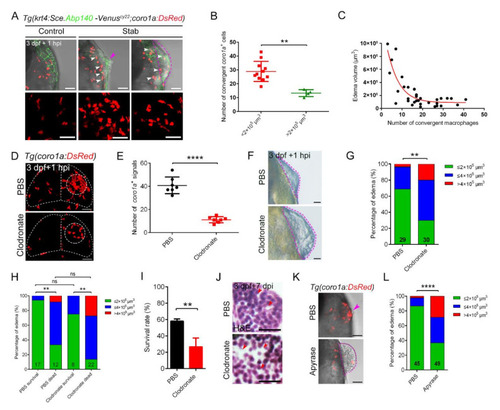Fig. 4
- ID
- ZDB-FIG-220927-68
- Publication
- Zou et al., 2022 - Macrophages Rapidly Seal off the Punctured Zebrafish Larval Brain through a Vital Honeycomb Network Structure
- Other Figures
- All Figure Page
- Back to All Figure Page
|
The dense structure of macrophages played an important role in maintaining brain integrity and survival of injured zebrafish larvae. (A) Edematous phenotypes appeared in injured Tg(coro1a:DsRed;krt4:Sce.Abp140-Venus)cy22 with a few macrophage aggregations. The white arrowheads in upper images indicate the distribution of macrophages after injury. Purple arrowhead indicates a mild edematous phenotype. The purple dotted line indicates a severe edematous phenotype. Scale bar, 50 µm. (B) Statistical analysis of aggregated coro1a+ cells number in (A). Control, 28.91 ± 2.19 n = 11; Stab, 13.25 ± 1.25 n = 4. (C) The correlation between edema-like symptoms and the number of aggregated macrophages. (D) The distribution of macrophages after injury with clodronate liposomes or PBS injection. Scale bar, 50 µm. (E) Statistical analysis of aggregated coro1a+ cells in (D). PBS, 40.86 ± 2.72 n = 7; Clodronate, 11.14 ± 0.99 n = 7. (F) Observation of edema-like symptoms after injury. Scale bar, 50 µm. (G) Statistics of edematous symptoms in (F). (H) Analysis of zebrafish survival and edematous symptoms in Clodronate/PBS treatment group after injury. (I) Survival rate of zebrafish at 1 dpi. (J) H&E staining of brain tissue at 7 days after injury. Scale bar, 10 µm. Red arrowheads indicate locations of apparent tissue loss. (K) The bright field and fluorescent images of coro1a-DsRed+ cells and edema-like symptoms by treatment with Apyrase/PBS. Scale bar, 50 µm. Purple arrowhead indicates a mild edematous phenotype. The purple dotted line indicates a severe edematous phenotype. (L) Statistics of edematous symptoms by treatment with apyrase/PBS. (Data are shown as mean ± SEM. ns, no significance; **, p < 0.01; ****, p < 0.0001.) |

